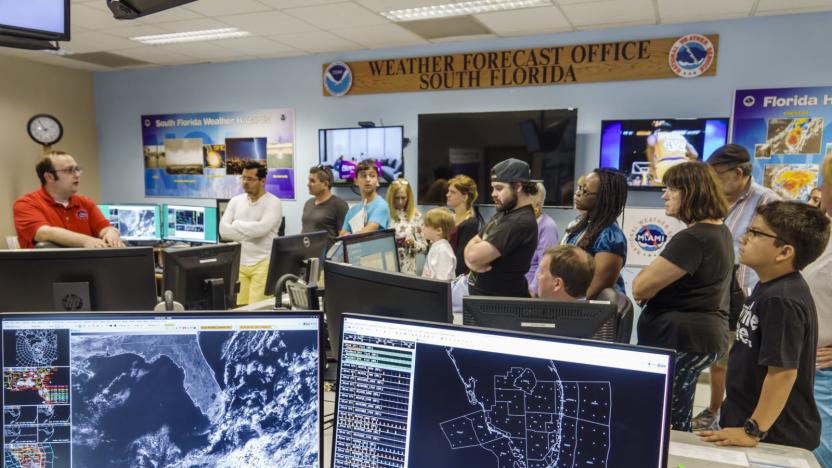meteorology
Latest

US weather forecast model gets a much-needed upgrade
Meterology revolves as much around good weather models as it does good weather data, and the core US model is about to receive a long-overdue refresh. NOAA has upgraded its Global Forecast System with a long-in-testing dynamical core, the Finite-Volume Cubed-Sphere (aka FV3). It's the first time the model has been replaced in roughly 40 years, and it promises higher-resolution forecasts, lower computational overhead and more realistic water vapor physics.

Forecast data model warns you of tornadoes hours in advance
Meteorologists usually only issue warnings for tornadoes when they're imminent, which gives you precious little time to take cover -- the American average is just 13 minutes. NOAA researchers may soon give you much more time to get to safety, though. They recently conducted the first practical test of a new model, Warn on Forecast, that gives you up to 3 hours' notice. The technique merges radar, satellite and surface data into a highly detailed prediction model. When you make frequent-enough predictions (every 15 to 20 minutes), you can tell when incoming weather patterns are very likely to trigger warnings.

The Big Picture: The frozen US as seen from space
Wondering why February has been so mind-numbingly cold? Here's why. NASA's Terra research satellite took a snapshot on February 19th showing that much of the US has been draped in Arctic and Siberian air masses, painting the country white with snow. Even southern cities like Macon, Georgia dipped well below freezing, according to weather reports. While those conditions are (thankfully) going away, they made for a spectacular view from space -- not that you'll likely want to see it again.

Moving wind forecast puts beautiful weather in your browser
It's hard to get excited about weather forecasts unless they promise warm and sunny days, but you might just make an exception for Windyty. The browser-based meteorological tool shows you living, breathing view of the world's wind patterns along with overlays for everything from temperature to humidity. Arguably, it's both beautiful and useful -- those mesmerizing swirls will help you understand why it's going to be unusually blustery or chilly on a given day. The page works on both your phone and desktop, too. There are still some definite holes in Windyty's map (it doesn't show borders or cities right now), but it's worth a look if you're done with old-fashioned weather charts and radar views.

Google brings current weather conditions to Google Earth, confirms it is, indeed, still raining in Pittsburgh
Google's busted out Google Earth 5.2, and all you meteorology nuts are going to want to hear about this. The update includes current weather condition imaging such as rain and snow cover in the radar layar with the cloud cover view on. Now, we love seeing weather maps as much as the next guy, but we're also pretty bad at predicting what's going to happen next based on those images, so we'll just leave that to the pros for now. Either way, if you're lucky enough to live in the U.S. and some parts of Europe, that feature is currently available.

Infrared sensors hit 16 megapixels, can now spy on an entire hemisphere
Aerospace and defense manufacturer Raytheon wants everyone to know it has developed the world's first 16 megapixel infrared sensor, which is set for a life of orbiting the Earth and generally being a lot more useful than lesser models. With its higher resolution, the unit is able to cover an entire half of the planet without "blinking" to relocate its focus, and should be warmly received by meteorologists, astronomists and military types, all craving for a bit more real-time reconnaissance. We advise wide-brimmed tin foil hats to shield your body heat from these Sauron-like satellites while working on those plans for a global uprising of the proletariat. [Via TG Daily]

Cellphone towers beat radar at detecting rain, say researchers
Proving once again that wireless technology isn't all bad, researchers from the University of Tel Aviv have determined that cellphone towers are as good as, if not better than, traditional meteorological techniques at measuring rainfall patterns. The team took data already documented by the carriers about each tower's signal strength over time and compared it to information that had been collected by radar and rain gauges, and found that not only did the towers accurately detect the electromagnetic disturbances inherent to storms, but that the degree of change in signal strength was directly proportional to actual rainfall. While widespread utilization of this data could probably have an immediate effect on forecasting if combined with current methodology, the researchers have an even more ambitious goal of detecting signal variations from the end-user -- that is, on consumers' handsets -- for aggregation into even more precise and localized reports once weather-related changes can be teased out from among the many other signal strength variants.[Via Slashdot]
